Experience: 4 years
12 Home Remedies For Athlete’s Foot And Prevention Tips
Potent at-home remedies to help you manage and eliminate this fungal overgrowth.
Medically Reviewed by Caroline DuncanCaroline Duncan, MD
Expertise: Psychiatry, Neurology, and Pharmacology
Experience: 4 years
Caroline C. Duncan graduated from the Medical University of South Carolina in May of 2017, where her interests were primarily psychiatric, neurologic, and pharmacologic in nature. She served on the editorial board for the school’s literar. more
Expertise: Psychiatry, Neurology, and Pharmacology
Experience: 4 years
Caroline C. Duncan graduated from the Medical University of South Carolina in May of 2017, where her interests were primarily psychiatric, neurologic, and pharmacologic in nature. She served on the editorial board for the school’s literar. more
Expertise: Home Remedies
Experience: 3 years
Shaheen holds a postgraduate degree in Human Genetics and Molecular Biology from Bharathiar University. She is a Geneticist with proficiency in Biotechnology, Immunology, Medical Genetics, Biochemistr. more
Expertise: Home Remedies
Experience: 3 years
Shaheen holds a postgraduate degree in Human Genetics and Molecular Biology from Bharathiar University. She is a Geneticist with proficiency in Biotechnology, Immunology, Medical Genetics, Biochemistr. more
Shaheen NaserShaheen Naser • December 27, 2022
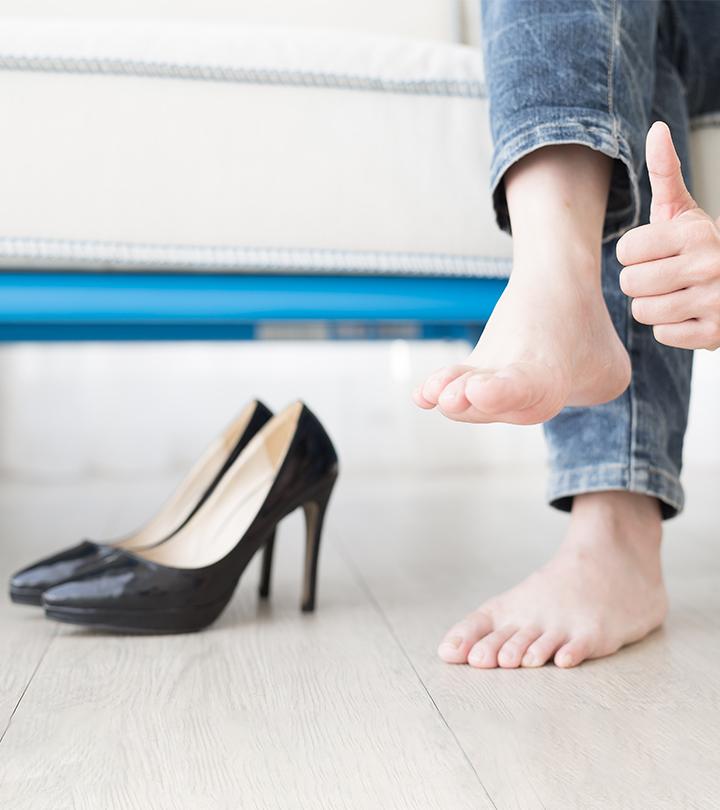
Athlete’s foot is a fungal infection commonly seen in athletes and people who engage in regular physical activity. Painful and itchy, you are at an increased risk of developing athlete’s foot if you wear sweaty socks and don’t air your feet out. While athlete’s foot is a serious health condition that requires medical attention, a few natural remedies can alleviate the symptoms quickly. In this article, we look at athlete’s foot and a few remedies you can try at home!
In This Article
What Is Athlete’s Foot?
Athlete’s foot is a fungal infection that affects the skin on the feet. It is contagious and is medically known as tinea pedis. This fungal infection can also spread to the toenails and the hands.
This infection is termed as athlete’s foot because it is mostly seen in athletes. It is often accompanied by the following symptoms.
Symptoms Of Athlete’s Foot
- An itchy, burning, and stinging sensation between the toes
- Itching or burning sensation on the soles of your feet
- Itchy blisters on the feet
- Cracking and peeling skin between the toes and on the soles of your feet
- Dry skin on the soles and/or sides of the feet
- The skin on your feet becomes raw
- Discolored, thick, and crumbly toenails
- Toenails that pull away from your nail bed
Let us now look at the main causes and risk factors for athlete’s foot.
Causes Of And Risk Factors For Athlete’s Foot
The main cause of athlete’s foot is a fungal infection caused by the growth of tinea fungus on your feet. You can contract it on direct contact with an infected individual or object. Since this fungus thrives in moist and warm environments, it can be commonly found in showers, locker room floors, and around swimming pools.
Although everyone is susceptible to developing athlete’s foot, some people are at an increased risk. Factors that could be held responsible for increasing your risk of developing athlete’s foot are:
- Going barefoot to public places like swimming pools and showers
- Sharing utensils with an infected person
- Wearing tight-fitting shoes
- Keeping your feet soaked and covered for long periods
- Having sweaty feet
- Minor skin or nail injury on your foot
Athlete’s foot can be classified into different types depending on the kind of infection and the area of the foot affected. The three main types of athlete’s foot are discussed below.
Types Of Athlete’s Foot
- Interdigital: This type of infection is also known as toe web infection. It usually occurs between the smallest of your toes and might even spread to the soles.
- Moccasin: This can result in dry and peeling skin on your foot. It may affect the entire sole and can even spread to the sides of your foot.
- Vesicular: This is the least common kind of athlete’s foot. It is usually categorized by a sudden outbreak of fluid-filled blisters under the skin. These blisters usually develop under your feet, but in some cases, they can also appear between your toes, on the heels, or on your feet.
Nobody wants to experience the constant itchiness and pain that usually accompany this condition. And given that it takes its own sweet time to heal, you need to take some immediate measures to address the issue. The following home remedies can help in treating athlete’s foot and speeding your recovery to a great extent.
Home Remedies To Treat Athlete’s Foot
How To Get Rid Of Athlete’s Foot Naturally
1. Apple Cider Vinegar
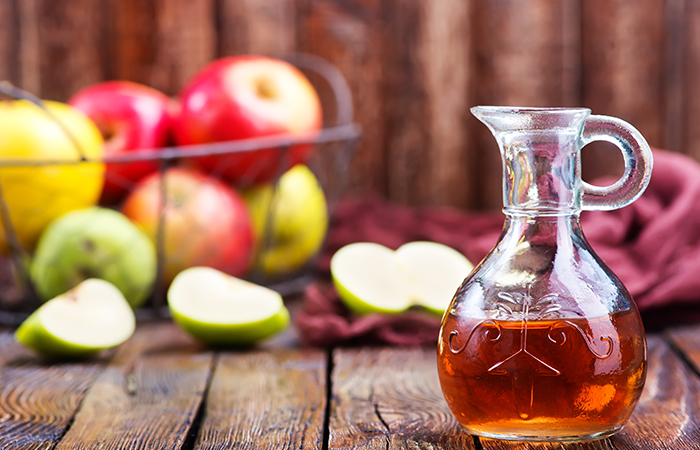
You Will Need
- 1/2 cup of apple cider vinegar
- 2 cups of warm water
What You Have To Do
- Take two cups of warm water in a bowl and add half a cup of apple cider vinegar to it.
- Soak your feet in this solution for 10 to 15 minutes.
- Pat your feet dry.
How Often You Should Do This
You must do this twice daily for best results.
Why This Works
Apple cider vinegar, with its anti-inflammatory properties, can prove to be quite useful in reducing the inflammation and pain. It also helps in destroying the fungal infection responsible for causing athlete’s foot with its antifungal properties (1).
2. Essential Oils
a. Lavender Oil
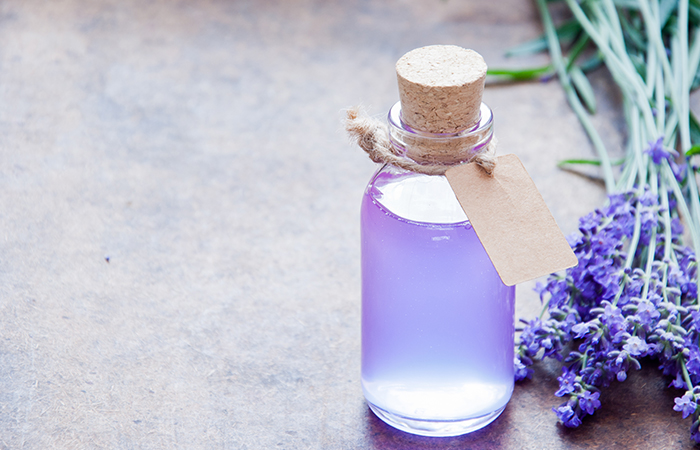
You Will Need
- 12 drops of lavender oil
- 30 mL of any carrier oil (coconut or almond oil)
- Water (optional)
What You Have To Do
- Add 12 drops of lavender oil to 30 mL of any carrier oil.
- Apply this mixture directly to the affected area on your foot and allow it to dry.
- Alternatively, you can add the lavender oil mixture to two cups of water and soak your feet in it for 10 to 15 minutes.
How Often You Should Do This
You must do this 2 to 3 times daily.
Why This Works
The antifungal, anti-inflammatory, and analgesic properties of lavender oil help in fighting the fungus that causes athlete’s foot (2), (3).
b. Peppermint Oil
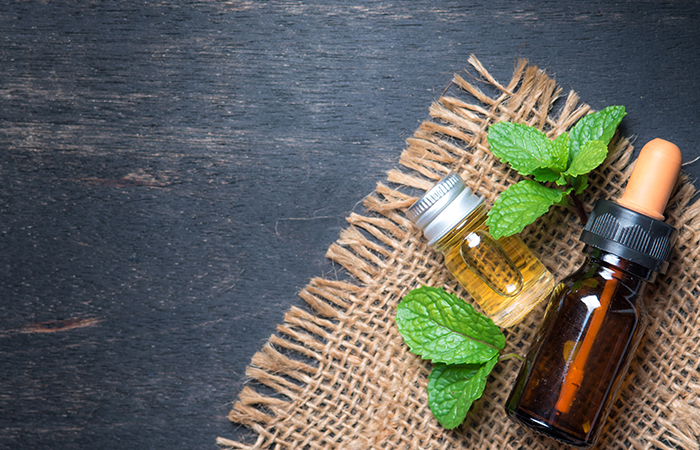
You Will Need
- 12 drops of peppermint oil
- 30 mL of any carrier oil (coconut or almond oil)
- Water (optional)
What You Have To Do
- Mix 12 drops of peppermint oil with 30 mL of any carrier oil.
- Apply this mixture to the affected areas.
- You can also add some warm water to this mixture and use it as a foot soak.
How Often You Should Do This
Do this three times daily.
Why This Works
Peppermint oil contains menthol, which possesses anti-inflammatory and soothing properties that help reduce pain and inflammation (4). It also has antifungal properties that eliminate the infection-causing fungi (5).
c. Tea Tree Oil

You Will Need
- 12 drops of tea tree oil
- 30 mL of any carrier oil (coconut or almond oil)
- Water (optional)
What You Have To Do
- Add 12 drops of tea tree oil to 30 mL of any carrier oil and mix well.
- Apply this mixture to the affected foot and allow it to dry.
- You can also add some water to this oil mixture and use it as a foot soak.
How Often You Should Do This
You must do this 2 to 3 times daily.
Why This Works
The antimicrobial properties of tea tree oil help in treating many skin conditions, including athlete’s foot. Tea tree oil possesses anti-inflammatory properties that help in reducing inflammation, swelling, and pain (6), (7).
3. Baking Soda

You Will Need
- 1 tablespoon of baking soda
- Water (as required)
What You Have To Do
- Mix a tablespoon of baking soda with a few drops of water to form a thick paste.
- Apply this paste to the affected areas and allow it to dry.
- Rinse thoroughly and pat your skin dry.
How Often You Should Do This
You must do this at least twice daily.
Why This Works
Baking soda is a natural antiseptic that helps prevent the development of secondary infections in the affected foot (8). It also keeps the area moisture-free, which, in turn, makes it uninhabitable for the fungus responsible for causing the infection (9).
4. Coconut Oil
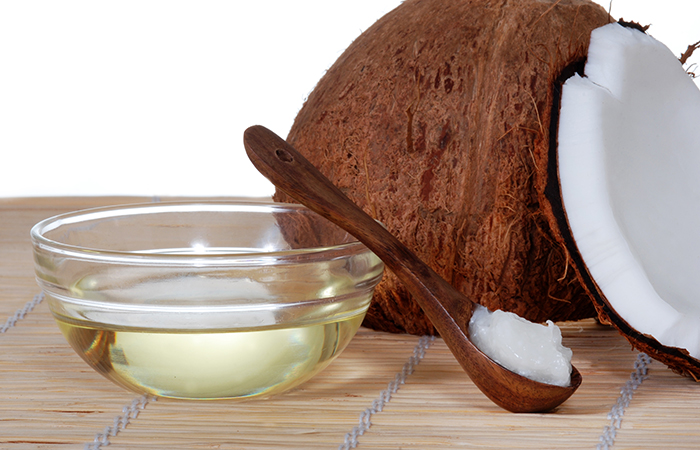
You Will Need
2-3 drops of coconut oil
What You Have To Do
- Apply two to three drops of coconut oil to the affected area.
- You can either allow it to be absorbed by your skin or keep it on for 20 minutes and then wash it off with water.
How Often You Should Do This
You can do this 3 to 4 times daily, at regular intervals.
Why This Works
Coconut oil is another amazing remedy for athlete’s foot. Its antifungal properties destroy the tinea pedis fungus, while its anti-inflammatory and analgesic properties soothe the affected area (10), (11).
5. Garlic
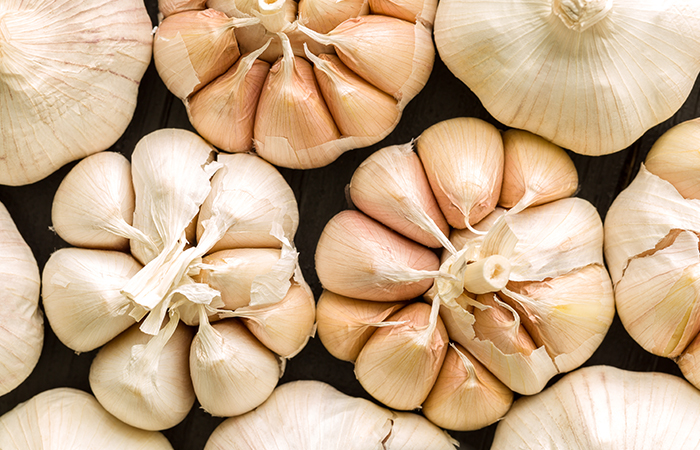
You Will Need
- 2 cloves of peeled garlic
- 2-3 drops of olive oil
What You Have To Do
- Take two cloves of peeled garlic and mince them to form a thick paste.
- Add two to three drops of olive oil to this paste and mix well.
- Apply this paste to the affected areas.
- Leave it on for 20 to 30 minutes, after which you can wash it off with water.
How Often You Should Do This
You must do this 1 to 2 times for a few days until you notice an improvement in your condition.
Why This Works
Garlic contains compounds like ajoene and allicin, which impart antifungal and anti-inflammatory properties to it (12), (13), (14). This is why its topical application works wonders in getting rid of athlete’s food and its painful symptoms.
6. Ginger
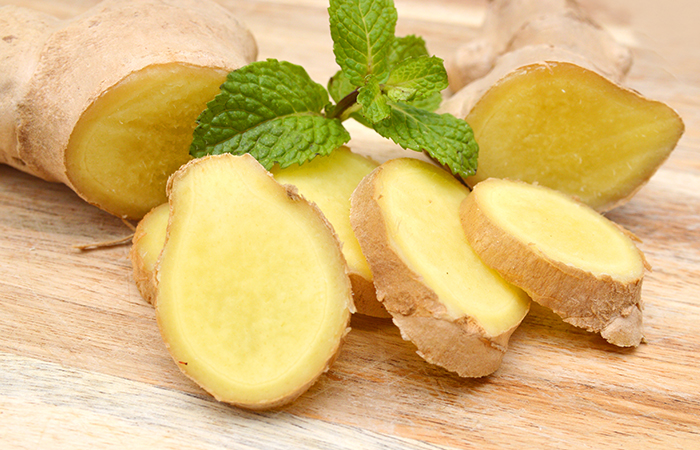
You Will Need
- An inch or two of peeled and cut ginger
- 1 cup of hot water
What You Have To Do
- Add some cut ginger to a cup of water.
- Allow it to boil and simmer for 10 to 20 minutes.
- Strain and let it cool for a while.
- Apply a few drops of this solution to the affected area.
How Often You Should Do This
You must do this 3 to 4 times daily.
Why This Works
Ginger is another herb that can be used to treat athlete’s foot. It exhibits antifungal and anti-inflammatory properties that help to get rid of the inflammation and bad odor associated with the condition (15), (16).
7. Grapefruit Seed Extract
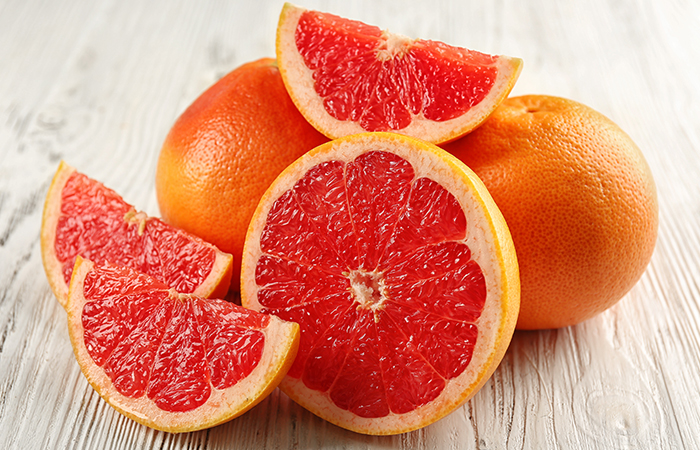
You Will Need
2-3 drops of grapefruit seed extract
What You Have To Do
- Apply two to three drops of grapefruit seed extract evenly to the affected area.
- Leave it on for 10 to 15 minutes and then wash it off with water.
How Often You Should Do This
Do this 2 to 3 times daily.
Why This Works
Grapefruit seed extract possesses excellent antifungal and antimicrobial activities that can help in relieving the symptoms associated with athlete’s foot and fight the underlying infection (17), (18).
8. Jojoba Oil
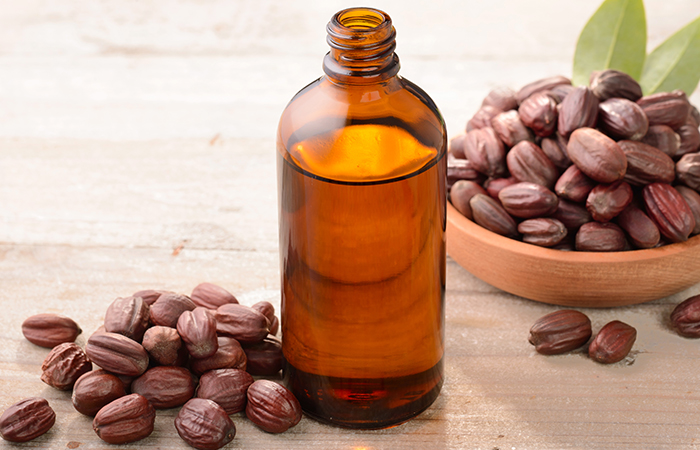
You Will Need
2-3 drops of jojoba oil
What You Have To Do
- Apply a few drops of jojoba oil directly to the affected area.
- Leave it on for 20 to 30 minutes, after which you can wash it off with water.
- You can also leave the oil on your skin to be absorbed.
How Often You Should Do This
You must do this 2 to 3 times daily.
Why This Works
Jojoba oil is widely known for its powerful anti-inflammatory and antifungal properties (19), (20), (21). These properties fight the fungus responsible for causing the infection and alleviate the symptoms of the infection.
9. Neem Oil
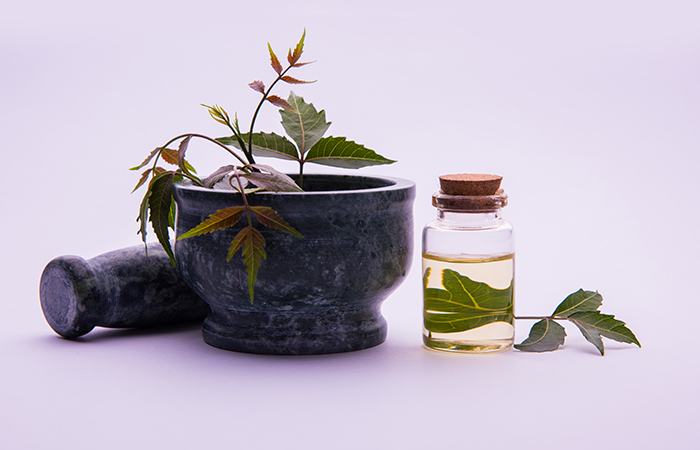
You Will Need
2-3 drops of neem oil
What You Have To Do
- Apply two to three drops of neem oil to the affected area.
- Leave it on for 15 to 20 minutes and then wash it off with water.
How Often You Should Do This
You must do this once daily.
Why This Works
The potent antifungal properties of neem oil help in the treatment of athlete’s foot (22). Also, its anti-inflammatory properties relieve the inflammation that is often associated with the condition (23).
10. Hydrogen Peroxide
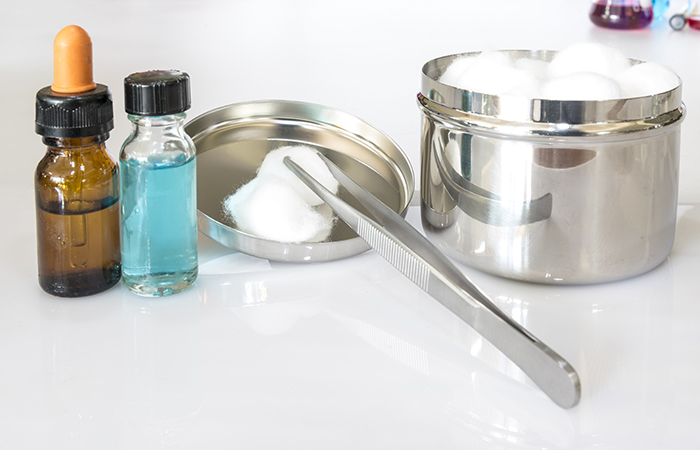
You Will Need
- 1 tablespoon of 3% hydrogen peroxide
- 1 tablespoon of water
- Cotton pads
What You Have To Do
- Mix a tablespoon of 3% hydrogen peroxide with a tablespoon of water.
- Dip a cotton pad in this solution and apply it to the affected areas.
- Allow it to dry naturally.
How Often You Should Do This
You must do this 2 to 3 times daily.
Why This Works
The antiseptic nature of hydrogen peroxide helps in disinfecting the affected area and prevents secondary microbial infections. Hydrogen peroxide also exhibits antifungal properties that fight the underlying fungal infection responsible for causing athlete’s foot (24).
11. Turmeric

You Will Need
- 1 teaspoon of turmeric powder
- Water (as required)
What You Have To Do
- Take a teaspoon of turmeric powder and add a few drops of water to it to make a paste.
- Apply the paste to the affected foot.
- Leave it on for 15 to 20 minutes and wash it off with water.
How Often You Should Do This
You must do this twice daily.
Why This Works
Turmeric contains a compound called curcumin, which possesses remarkable antifungal, antibacterial, and anti-inflammatory properties that help treat athlete’s foot (25), (26).
12. Epsom Salt

You Will Need
- 1 cup of Epsom salt
- Water
What You Have To Do
- Add a cup of Epsom salt to a large bowl of warm water and allow it to dissolve.
- Soak your feet in the solution for 10 to 15 minutes.
How Often You Should Do This
Do this 1 to 2 times daily.
Why This Works
An Epsom salt foot soak is an easy and effective remedy to get rid of athlete’s foot. Epsom salt contains magnesium, which possesses anti-inflammatory properties and helps treat the condition (27), (28).
Stylecraze Says
Avoid wearing closed or tight shoes, especially in hot weather. They can squeeze your feet and make them prone to an infection due to the sweaty environment.
Now that you know how to get rid of the fungal infection, there are a few things you must do to prevent its recurrence. They are as discussed below.
Prevention Tips
- Wash your feet with soap and water daily (the temperature of the water should be 60ºC or higher to kill the fungus).
- Dry your feet after every wash.
- Apply the antifungal powder prescribed by your doctor on your feet daily.
- Do not share your shoes, socks, and towels with others.
- Wear socks made of breathable fibers like cotton.
- Change your socks daily, especially if your feet tend to get sweaty easily.
- Alternate between two pairs of shoes. This is to give each pair ample time to dry before it is used again.
Stylecraze Says
Keep your toenails clean and trimmed short because dirty nails can get infected easily. Also, make sure to use sanitized nail clippers.
If left unattended or untreated for too long, athlete’s foot can also lead to the following complications.
What Happens If You Leave Athlete’s Foot Untreated?
Athlete’s foot can cause mild to severe complications if you leave it untreated for too long. They include:
- An allergic reaction to the tinea fungus, which may cause blistering.
- Development of a secondary bacterial infection, accompanied by swelling and pain in your foot.
- The bacterial infection can also spread to your lymph system and cause infections in your lymph nodes and lymph vessels.
Infographic: Athlete’s Foot: When Should You Seek Medical Attention?
Using over-the-counter remedies and performing self-care at home for a week should result in some improvement. However, if you haven’t observed any progress or the condition worsens, contact your doctor immediately. It is critical to seek treatment as soon as possible before the infection spreads to the rest of your foot or other regions of your body, including your groin or toenails. Check out the infographic below to learn more about seeking medical attention with an athlete’s foot.
![Home Remedies For Athlete's Foot athlete’s foot when should you seek medical attention [infographic]](https://cdn2.stylecraze.com/wp-content/uploads/2022/09/Athletes-Foot-When-Should-You-Seek-Medical-Attention.jpg)
Athlete’s foot is a fungal infection that is mainly seen in athletes. Wearing sweaty socks and engaging in regular physical activity may increase the risk of athlete’s foot. Natural remedies like apple cider vinegar, baking soda, essential oils, Epsom salt, turmeric, neem oil, ginger, coconut oil, and grapefruit seed extract effectively manage athlete’s foot. In addition, garlic and hydrogen peroxide alleviate the symptoms of this condition. Washing your feet with soap and water regularly, drying the feet, and using anti-fungal powders and socks made with breathable fiber reduces the risk of athlete’s foot.
Frequently Asked Questions
Is athlete’s foot contagious?
Yes, athlete’s foot is highly contagious. Direct contact with infected individuals or objects can cause it to spread.
What kills the fungus on the feet?
You can kill the fungus by washing your feet daily with soap and hot water (60ºC or higher). You can also use topical antifungal medications or any of the above remedies to get rid of the fungus naturally.
How long does it take to get rid of athlete’s foot?
Depending on the course of treatment, it can take anywhere from 1 to 4 weeks to heal completely. You will start noticing a positive change in your condition in a week.
Should I wear socks to bed with athlete’s foot?
You may want to wear socks if you share a bed with someone to reduce the risk of transmitting the fungus to them.
Does rubbing alcohol cure athlete’s foot?
Anecdotal evidence suggests that soaking the affected foot in a solution made of rubbing alcohol and water or applying rubbing alcohol directly to the area can help relieve the symptoms and facilitate healing.
How do you disinfect shoes from athlete’s foot?
You can use a UV shoe sanitizer to disinfect shoes from the fungus that causes athlete’s foot. Other alternatives include washing the shoes in hot water with an antifungal disinfectant and keeping them under direct sunlight to dry properly.
Does baby powder help with athlete’s foot?
There is no evidence to suggest that baby powder can help with athlete’s foot beyond keeping the feet dry for a brief period of time.
Can you get a pedicure if you have athlete’s foot?
You may get a pedicure when you have athlete’s foot, but it is not recommended. It would be best to reschedule till the infection clears up or to let your pedicurist know about your condition so that they can take steps to lower the risk of transmission.
Is it okay to take a bath if you have athlete’s foot?
It is okay to take short baths if you have athlete’s foot, but you should avoid taking a bath if you share a bathroom with someone else so that the fungus does not spread. Also, you need to clean and dry your feet properly after bathing.
Home Remedies for Athlete’s Foot
We include products we think are useful for our readers. If you buy through links on this page, we may earn a small commission Here’s our process.
How we vet brands and products
Healthline only shows you brands and products that we stand behind.
- Evaluate ingredients and composition: Do they have the potential to cause harm?
- Fact-check all health claims: Do they align with the current body of scientific evidence?
- Assess the brand: Does it operate with integrity and adhere to industry best practices?
You may be able to treat athlete’s foot with over-the-counter products and items in your medicine cabinet, including certain oils and talcum powder.
Athlete’s foot, also known as tinea pedis, is a fungal skin infection that typically starts between the toes. It causes a scaly, itchy rash that may have painful or burning sensations. In some cases, people may also experience ulcers or blisters, which can be very painful.
Fortunately, athlete’s foot can be extremely receptive to home treatment. Here are 10 home treatments that are known to be effective.
There are a number of over-the-counter (OTC) treatments available for athlete’s foot. These can come as powders, sprays, ointments, and lotions. Many cases of athlete’s foot respond well to OTC treatments and may never require other options.
You can apply these treatments directly to the affected area and use them for at least 1 week after symptoms resolve to prevent the infection from immediately returning.
Hydrogen peroxide can effectively kill the fungus on the surface level of the foot, as well as any surface bacteria that could cause an infection.
Pour hydrogen peroxide directly onto the affected area. Note that it may sting, and it should bubble, especially if you have open wounds. Do this twice daily until the infection subsides.
Tea tree oil has antifungal and antibacterial properties, which is part of the reason it’s commonly used to treat many fungal infections (including both ringworm and candidiasis).
One 2002 study found that applying tea tree oil daily could treat both the symptoms of athlete’s foot and the fungus that causes it within a few weeks.
To treat athlete’s foot, mix a carrier oil like warm coconut oil with tea tree oil for a concentration of 25 to 50 percent tea tree oil. Apply it to the affected area two times a day.
Both neem oil and neem leaf extracts have incredible antifungal capabilities that can help fight athlete’s foot. You can apply the neem oil (or extract) directly to the affected area two to three times a day, massaging it into the skin. This can also be helpful for treating infections that develop under the toenails.
Much like hydrogen peroxide, many families will have rubbing alcohol on hand to clean cuts. Like hydrogen peroxide, rubbing alcohol can help kill off the fungus that’s on the surface level of the skin.
You can apply it directly to the affected area or soak your feet in a footbath of 70 percent rubbing alcohol and 30 percent water for 30 minutes.
Garlic may have a strong scent, but it can be an effective topical treatment for athlete’s foot. One older study even found that a derivative of garlic, alone, resulted in a complete cure in 79 percent of participants after just 7 days.
To use garlic to treat athlete’s foot, crush four to five cloves of garlic. Once smashed, rub them over the affected area. Do this twice daily.
Sea salt has strong antibacterial and antifungal properties , making it a great natural treatment for athlete’s foot and any complications it could cause. It may actually inhibit the growth and spread of athlete’s foot.
Some treatments involve mixing sea salt with other natural treatments, like vinegar, to make a sort of paste. The most effective way to use this treatment may be to dissolve a cup of sea salt into a warm foot bath. Soak your feet for at least 20 minutes. Dry your feet thoroughly when you’re finished soaking.
Talcum powder, corn starch, or baby powder work to treat athlete’s foot by keeping the affected area dry and clean. This makes it difficult for the fungus to thrive and spread by keeping sweat and moisture under control.
To use this treatment, apply talcum powder (or antifungal powder) directly to the dried, affected area every time before putting on socks. Be careful not to inhale talcum powder.
Not only can Vicks VapoRub reduce symptoms from a bad cough, it can help treat athlete’s foot. This may be because of its use of eucalyptus oil and menthol, both of which have antifungal properties
Rub Vicks on the affected area every night, massaging it into the foot. Do this every night for at least a month, or up until a week after the infection has disappeared.
It’s important to prevent athlete’s foot. Fungus can grow in dark, moist areas, making your feet an ideal place for athlete’s feet to develop. If you have athlete’s foot (or even if you just want to prevent it), keep your feet as dry and clean as possible.
Change your socks regularly. As soon as you’re done working out, clean your feet and put on a fresh pair of socks. Dry the space between your toes. Don’t go barefoot in public pool or gym areas.
You should also use shoes that are well ventilated and allow your feet to breathe to help athlete’s foot resolve more quickly.
If untreated, athlete’s foot can result in a bacterial infection if skin is broken. This can happen due to scratching or when blisters pop or ulcers become infected. Any type of infection can be very serious and requires prompt treatment.
Athlete’s foot is also very contagious. It can easily spread to your hands, especially if you’re scratching at the affected area. This fungus can also infect the area under your nails, which can be more difficult to treat, or the groin area.
If you think you have athlete’s foot and it hasn’t subsided after a week of home treatment, make an appointment to see your doctor. You may need prescription antifungals (either oral or topical) to get rid of the infection.
You should also make an appointment to see your doctor if you have athlete’s foot and diabetes. This is especially true if you have signs of a secondary bacterial infection, which can be more dangerous in those with diabetes due to their nerve damage.
Signs of infection include redness, pus, swelling, drainage, and fever. If you have diabetes, you may not feel pain in your feet due to nerve damage.
Your doctor will likely be able to diagnose athlete’s foot just by looking at it.
Because athlete’s foot is contagious, make sure you avoid scratching or touching the area except when treating the affected area.
Wash your hands before and after applying treatment. This can help prevent the foot from developing a bacterial infection and prevent the fungal infection from spreading to other parts of your body.
Last medically reviewed on October 25, 2019
6 Proven Home Remedies for Athlete’s Foot

Got more than just a great workout at the gym? Feeling an itching burning on the crevices and tops of your feet? Is the skin on your feet starting to look scalier than a lizard? Sounds like you may have a case of athlete’s foot.
Athlete’s foot is a fungal infection that loves to live in damp, warm areas. You can typically find the fungus of this infection between your toes, between your fingers, on the toenails, and on the tops of your feet.
Symptoms of Athlete’s Foot
Not sure if you have athlete’s foot? This infection typically starts out between the toes with a red scaly rash. This rash is really itchy, especially right after you take off your shoes.
Some people mistake athlete’s foot for eczema because the rash often takes on a scaly appearance accompanied with patches of dry skin. Athlete’s foot can affect one or both of the feet. Be careful, this rash can spread to your hands if you scratch or pick at the rash.
If your rash does not clear up after a couple weeks of treatment, schedule an appointment with your physician. You should also seek medical assistance if you have diabetes or if your rash is accompanied with a fever, or excessive swelling, redness, or draining.
What Causes Athlete’s Foot?
Athlete’s foot is born through the same fungus responsible for causing jock itch and ringworm. This fungus thrives in humid and warm conditions that encourage its growth.
Athlete’s foot is extremely contagious and can easily spread or contracted. Athlete’s foot is spread through contact with contaminated surfaces such as floors, shoes, and towels, or through contact with a contaminated person.
Who is Most at Risk for Contracting Athlete’s Foot?
You may be most at risk for contracting athlete’s foot if you fit the following criteria:
- You are a man
- You share shoes, clothes, mats, linens, and towels with a person suffering from a fungal infection.
- You wear tight fitting shoes and damp socks
- You walk barefoot in public areas where the fungus grows wild such as communal showers, locker rooms, pools, and saunas
- You have a weak immune system
See also 10 Amazing Benefits of Coriander Seed Essential Oil
Home Remedies for Athlete’s Foot
Athlete’s foot is a common condition that can easily be treated with the following home remedies:
1) Tea Tree Oil
This powerful natural antiseptic is loaded with anti-fungal, anti-bacterial, and anti-microbial properties that will eliminate the fungus and prevent the infection from spreading.
Tea tree oil will also help kill stubborn fungus that has spread to the nails and toenails. There three different ways you use tea tree oil as a treatment:
For a soothing mixture, mix three drops of tea tree oil with one part aloe vera gel. Thoroughly wash and dry you feet. Rub this mixture directly onto the affected area for six or so weeks until the infection clears up.
- To apply tea tree oil directly to the area, dilute the area with a carrier oil such as olive oil.
- Mix equal parts of tea tree oil with the carrier oil and apply directly to the affected area.
- Before applying the tea tree oil, be sure to wash and dry your feet.
- Apply this treatment 3-4 times a day until the infection clears up.
For a healing foot soak, add 40 drops of tea tree oil to your foot-bath. Let soak for 10 minutes. After soaking your feet, thoroughly dry your feet and apply a couple drops of tea tree oil directly to the infected area.
2) Apple Cider Vinegar
The acidity of apple cider vinegar will help kill the fungus and help zap the infection. Apple cider vinegar is also loaded with antibacterial, anti-fungal, and anti-microbial properties that will help eliminate infection and will prevent the infection from spreading. To use apple cider vinegar as a treatment:
- Mix one-part apple cider vinegar with 3 parts warm water in your foot-bath.
- Soak the infected foot or feet for 15 minutes.
- Once you’re through soaking your feet, dry them thoroughly.
- Repeat this treatment once or twice daily for a week or until your infection is gone.
If you want to apply the apple cider vinegar directly to your feet, you can apply it directly with a cotton ball.
- First, wash your feet with antiseptic soap and then dry thoroughly.
- Mix one cup of apple cider vinegar with one cup of water.
- Dip a cotton ball into the mixture and then dab onto the affected area.
- Apply this remedy twice daily for several weeks to treat and prevent the spread of athlete’s foot.
See also Benefits of Nattokinase
3) Epsom Salt
Epsom salt will help soothe and treat the painful sores that accompany athlete’s foot. Epsom salt is a great home remedy for athlete’s foot because it easily absorbs into the skin.
It also contains sulfate and magnesium, which will help reduce painful inflammation while draining any toxins from your body. You can use regular salt for this treatment as well but it does not provide as much benefits as Epsom salt. To use Epsom salt to treat your athlete’s foot:
- Add Epsom salt to your footbath. Soak your feet for about 10 minutes.
- Thoroughly dry your feet after soaking.
- Do this remedy three times a day until the infection clears up.
4) Garlic
There is more to garlic besides its powerful taste and smell—its also a powerful anti microbial and anti-fungal. Garlic contains an anti-fungal compound called ajoene, which helps to eliminate the fungus responsible for the infection.
Garlic will help speed up the healing process while preventing the infection from returning. To use garlic as a home remedy, follow these guidelines:
- To make a healing garlic paste, crush a clove of garlic and mix it with a couple drops of olive oil.
- Gently apply the paste to infected area and let sit for 30 minutes.
- Wash off the area using an antibacterial soap.
- Thoroughly dry off your feet.
- Apply this remedy daily until the infection clears up.
5) Cornstarch or Baking Soda
The fungus responsible for athlete’s foot thrives in hot and moist areas. Cornstarch or baking soda won’t really address your uncomfortable symptoms but it will keep your feet dry and prevent the infection from occurring or getting worse.
- Simply sprinkle some cornstarch or baking soda between your toes before putting on your socks. Baking soda can double as a deodorant for your feet.
6) Onion
Did you know that onion is a fantastic anti-fungal? Onion also has effective anti-inflammatory properties that that help soothe the uncomfortable symptoms of athlete’s foot.
Meanwhile the antibacterial, anti-fungal, and antibiotic properties prevent this infection from spreading. To use onion to treat your athlete’s foot follow these guidelines:
- Grind up two onions and collect the juice using a strainer.
- Wash your feet with an antibacterial soap and then dry them off thoroughly.
- Apply the onion juice to the areas of your feet inflicted with athlete’s foot.
- Let sit for 30 minutes.
- Once the half hour is up, wash the onion juice off your feet and thoroughly dry your feet.
- Apply baking soda to your feet to keep the dry and free of infection.
See also Vanilla Essential Oil Demystified
Prevention
Athlete’s foot is a nasty business and fortunately with a little bit of effort, you can protect yourself from the infection by following these steps:
- If you’re going to be entering a public gym, pool locker room, sauna, etc., try wearing flip flops instead of going barefoot.
- After bathing, make sure you completely dry off your feet; especially between your toes.
- Keep your toenails the shortest length you can to prevent the fungus from living underneath your toenails. Toenails that are too long can retain moisture and make infection more likely.
- Don’t leave on sweaty socks or tight shoes on for longer than you have to.
- If you tend to have sweaty feet, keep a spare pair of cotton socks with you.
- If you sweat a lot while wearing a particular pair of shoes, do no wear them the next day. Let them properly dry and air out, making them less likely to house fungus.
July 12, 2016 By Angela Deckard Filed Under: Wellness






